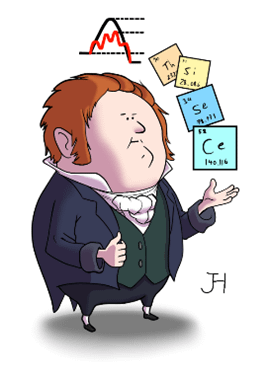
Welcome to the first in a new series of posts that provide an historical perspective on the scientists and their discoveries, that underpin our understanding of the mechanism of action of enzymes. Some of the links to these discoveries may seem a little tenuous at first, but I hope to persuade you otherwise. Sir Isaac Newton (left) famously wrote in a 1675 letter to fellow scientist Robert Hooke: “If I have seen further, it is by standing on the shoulders of giants.” I think this perfectly captures the journey of most scientists and the way in which scientific thinking has evolved. Serendipitous discoveries, inspired thinking, empirical experiments and perhaps, as Nobel laureate Sidney Brenner once suggested, technological breakthroughs, all come together to drive forward knowledge. The site is aimed at those who are new to Biochemistry whether young or old, and of course any feedback or suggestions, are always welcome: as Charles Buxton once said: “silence is sometimes the severest criticism”. Newton is universally regarded as a scientific genius and, although his work is not directly related to enzymes; without his invention of calculus (along with Gottfried Wilhelm Leibniz), our ability to describe the complexity of enzyme catalysed reaction rates would be extremely pedestrian. Newton also embodies the phenotype of many (but not all) an intellectual genius: a maverick, a rebel, an enthusiast, and an obsessive.
These posts are sponsored by Entropix, a young company, focusing on the development of enzymes, using technologies that have been made possible by the many experimental and intellectual breakthroughs that date back to the early pioneers of science. In this, the first post, I shall explore the origins of catalysis, which can be traced to early human activities: namely the conversion of sugars into alcohol. The earliest description of inorganic catalysis appeared in 1552, when Valerius Cordus used sulphuric acid to catalyse the conversion of alcohol to ether. However, the first systematic investigation of catalysis is generally attributed to the Swedish chemist, Jöns Jacob Berzelius (bottom left). Berzelius introduced and defined the term catalysis in 1835, as “the property of exerting on other bodies an action which is very different from chemical affinity. By means of this action, they (catalysts) produce decomposition in bodies, and form new compounds into the composition of which they do not enter”. Let’s unpick this definition from a wide perspective.
The starting point for understanding catalysis and enzymes requires an appreciation of the interactions that occur when two or more molecules collide. For the purposes of this discussion, we shall confine ourselves to molecular encounters in solution, that follow the principles of simple diffusion, and associated Brownian motion. Let us imagine that two molecules are represented by two small cubes, such as coloured dice (say red and green). Each face of the cube has a different number of dots (pips), and let’s assume that the 100 such dice are thrown together onto a table; when a red face with six pips meets a green face with six pips, in perfect alignment, a reaction occurs. This is referred to as a productive encounter: in contrast, if a non-matching pattern of pips combine, or more likely if there is no contact, or the contact is irregular (edge on for example), no reaction takes place. This is called a non-productive encounter. In very simple terms a catalyst promotes the formation of productive encounters and in doing so, increases the rate of the reaction and more molecules collide.

For even without an appreciation of the principles of chemical reactivity, I think it is easy to see a catalyst might operate by restricting the freedom of the dice to tumble, perhaps the opposite red face to the 6 pips (a single pip) is attracted to a surface, this leaves the red 6 pip face in a much more accessible position for a green 6. As a result, the probability of a productive encounter is increased. This isn’t meant to provide a full explanation of catalysis, but hopefully it helps explain the logic of the first step in the process. In fact, there are a number of strategies adopted by catalysts that enhance the rate of different types of reaction. I don’t have the space here to be comprehensive in my coverage, instead, subsequent posts will focus on examples of catalysis that have been particularly important in developing our understanding of this phenomenon, which, like most of science, still holds many “secrets”.

Chemists have traditionally focused on catalysis by inorganic metal salts, although a recent shift to the catalytic properties of small organic molecules is beginning to take centre stage (in 2021 Benjamin List and David MacMillan won the Nobel Prize in chemistry “for the development of asymmetric organic catalysis”). The study of biological catalysis, by contrast has mostly been dominated by the extraction, purification and kinetic analysis of protein based enzymes, such as ribonucleases, proteases and dehydrogenases. However, in the 1980s, it became apparent that a small number of “esoteric” RNA molecules, initially from microbes and lower eukaryotes, exhibited the properties of protein-based enzymes. This was recognised by the award of the Nobel Prize in Chemistry in 1989 to Sidney Altman and Thomas Cech. Whilst it seems that protein-based enzymes dominate biological catalysis, our understanding of the fundamental principles of enzyme catalysis have been enhanced by studying ribozymes. In fact, it is now known that the site of cellular protein synthesis, the ribosome, is itself a ribozyme at its core, supported by a complex network of accessory proteins.
So why have catalysts attracted so much attention in the past, and why are they so important for the future of medicine and sustainable manufacturing? The processing of food and drink has historically relied upon the catalytic properties of enzymes, such as rennet (proteases used in cheese making) and the bread-making (amylases), originally supplied as crude extracts of animal tissue or microbes, such as yeast. The ability of enzymes under relatively mild conditions (such as those associated with many living organisms, including Homo sapiens) to not only stimulate chemical reactions, but to do so with exquisite molecular selectivity (referred to as substrate specificity) and often with complete chiral control (ensuring only the correct optical isomer is produced). In this way, enzymes meet many of the criteria demanded of contemporary, sustainable manufacturing goals.
As the series of Blogs unfolds, and not always in a chronological direction, I shall use selected examples of enzymes and key scientists to illustrate the extent, and limitations of our current understanding of enzyme catalysis. However, before I go, I shall leave you with one very simple example of inorganic catalysis and its biological counterpart: the decomposition of hydrogen peroxide to water and oxygen. (If you are a young student reading this, I encourage you to ask your Chemistry teacher to show you this reaction in the school laboratory). In the absence of any catalysts, a solution of hydrogen peroxide at a fixed concentration and temperature, in water, decomposes at a specific rate, which can be influenced by increasing atmospheric pressure or the temperature. The reaction can also be enhanced by the addition of a catalyst. In one scenario, a transition metal compound such as manganese dioxide (an intense black solid), when added to hydrogen peroxide, leads to a vigorous reaction, which generates heat and steam (it is an exothermic process), and the interplay between the catalyst and the hydrogen peroxide molecules leads to an enhanced rate of decomposition. At the end of the reaction, the catalyst appears chemically unchanged (as noted by Berzelius) and can be recovered and reused. In many, but not all organisms, a class of enzymes, called catalases, enhance the rate of decomposition of H2O2, just as well as, and often faster than transition metals (it is true to say that all catalases do contain a metal ion at the site of catalysis: which we call the active site). However, importantly, the enzyme catalysed reaction, occurs at body temperature and any release of heat is dissipated during the reaction, throughout the protein itself. After catalysing the reaction of one peroxide molecule, the enzyme moves onto another, and another. Different enzymes exploit different reaction pathways in order to reach the equilibrium position of a reaction, converting substrates to products, via a transient intermediate species called the transition state: reaching the other side of a mountain does not always require climbing over the top! Interestingly, in biological terms, the decomposition of H2O2, a potentially toxic intracellular molecule, can be achieved by the selective import manganese ions, but catalase mediated decomposition seems to have won out in evolution. The latter observation reinforces the view that Nature harnesses Chemistry in a way that promotes the competitive survival of a species, and I hope I can infuse the Blog posts with examples of how Nature meets chemical challenges with diversity at the molecular level.
Dramatis personae
- Sidney Altman (Montreal, Canada; Yale, USA, 1939-2022
- Jöns Jacob Berzelius (Stockholm, Sweden, 1779-1848)
- Sydney Brenner (South Africa; Cambridge UK; Singapore,1927-2019)
- Thomas Cech (Colorado, USA, 1947-)
- Sir Robert Hook (Oxford; London, UK, Cambridge, UK, 1635-1703)
- Benjamin List (Max-Planck-Institut near Essen, Germany, 1968-)
- David MacMillan (Princeton, USA, 1968-)
- Sir Isaac Newton (Cambridge, UK, 1642-1727)
This and subsequent posts will be illustrated with images created by James Hornby, from whom you may request permission to use the images freely for educational purposes.
